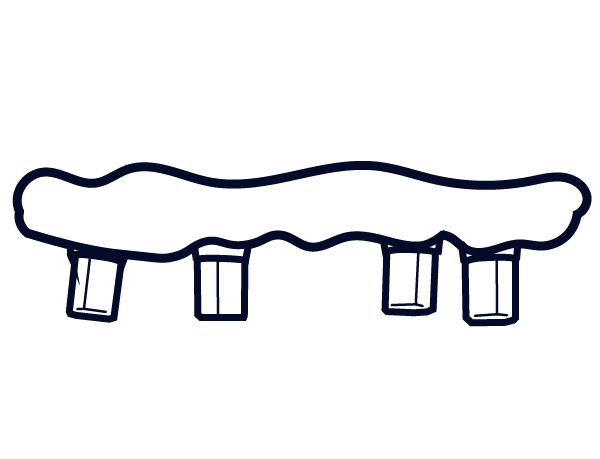DATA ACCEPTANCE
Osteon Medical accepts case orders using a variety of implant-capture technologies.
For full-arch cases, it is recommended to use proven solutions to achieve direct implant capture.
Other systems can be used, but may result in prosthetics that fit the provided data, and not necessarily the patients in-mouth setup.
Important to note that while Osteon accepts a multitude of data sets, only Nexus iOS Scan Gauge scan data can be digitally verified before prosthetic production.
Stone Models
Single, Bridge and Full-arch cases.
All traditional stone models require stable implant analogs and for analogs to be proud of the model in order to be effectively measured using a coordinate measuring machine (CMM).
GENERAL Workflow
-
Go to the Osteon Ordering Platform and place an order for your proposed framework or prosthesis type.
The order will be on hold until the models are received at Osteon.
-
Ensure that the model is stable, that all implant site analogs are non-mobile and that all other information is included, ie. tissue mask.
-
Once your case has been received and matched to your case it will begin review, the Osteon portal will be updated once the order progresses to design or to production.
Photogrammetry
Full-arch cases.
All photogrammetry systems require the file export from the camera units software, and relevant intraoral scans to attain other patient data.
Osteon accepts data from:
iCAM 4D
PiC
Micron Mapper
Tupel (Grammee)
SURGICAL WORKFLOW
-
Before new surgical cases begin, a pre-op virtual smile design (VSD) must be completed.
To do this, scans and photos of the patient must be acquired:
Intraoral Scans:
Maxillary arch dentition/denture/bite-block.
Mandibular arch dentition/denture/bite-block.
Bite Scan (Stabilized with wash impression if necessary).
Patient Photos:
Full-face, relaxed bite smiling.
Full-face relaxed bite smiling with retractors.
-
Follow the surgical steps in the Osteon portal.
Choose Pre-Op and immediacy and place an order for a VSD.
Note the date of surgery and include all necessary patient data before submitting.
-
Receive a proposal of the intended provisional restoration before the surgery.
This will serve as the basis of the immediate prosthetic. Ensure the case is closely reviewed and approved before the day of surgery.
-
On the day of surgery, scans are needed to match the pre-op scans and the edentulous arch with implants placed.
There are various ways to do this, three available strategies are:
Mid-surgery scan, using scan bodies on 2 of the implant sites half-way through surgery (only available is natural dentition was present).
Fiducial markers, using a marker like a palette screw as the alignment point (requires IOS scans of the arch with the marker placed before and after surgery).
Surgical Scan Template (SST) for fully edentulous cases. These are 3D printed denture-style shells placed after surgery with impression material to determine the new VD along with patient photos.
Additionally, implant capture is necessary using the photogrammetry camera.
-
Immediately after surgery scans have been captured, upload them to the existing case order on the Osteon ordering platform.
Depending on the order, expect a design for in-house printing or production at Osteon Medical.
-
Depending on the order, the immediate case will be uploaded for in-house production (3D printing) or produced and finished at Osteon Medical.
Restorative WORKFLOW
-
Before ordering a restorative case, new patient data needs to be captured.
Photogrammetry Scans:
Restoring arch scan output file.
Intraoral Scans:
Maxillary arch dentition/denture/prosthetic.
Mandibular arch dentition/denture/prosthetic.
Bite Scan (Stabilized with wash impression if necessary).
Tissue scan of the restoring arch.
Scan of the existing prosthesis extra-orally 360°
Patient Photos:
Full-face, relaxed bite smiling.
Full-face relaxed bite smiling with retractors.
-
Follow the restorative order steps in the Osteon portal.
Upload all patient data, photos and importantly all requests or changes from the existing provisional.
Any missed information or incorrect data will delay the case design.
-
Receive a proposal of the intended final restoration.
Ensure the case is closely reviewed, a Try-In can be provided before going to final
-
After the case design is approved, a Try-In can be uploaded/printed and dispatched from Osteon.
The Try-In is intended to test aesthetics with the patient.
Adjust the Try-In as necessary and then rescan the foundation scans (upper, lower, bite) as well as the 360 if the intaglio has been adjusted.
Try-In’s are not essential if the final restoration is a direct copy of the existing provisional.
-
Upload all new scans to the case order if changes are necessary.
Or, approve to go to production.
A secondary design can be requested after Try-In feedback in provided to ensure accurate design changes.
-
Case will move to production.
Depending on your case order and level of finishing, the case may take 3-15 working days to complete.








